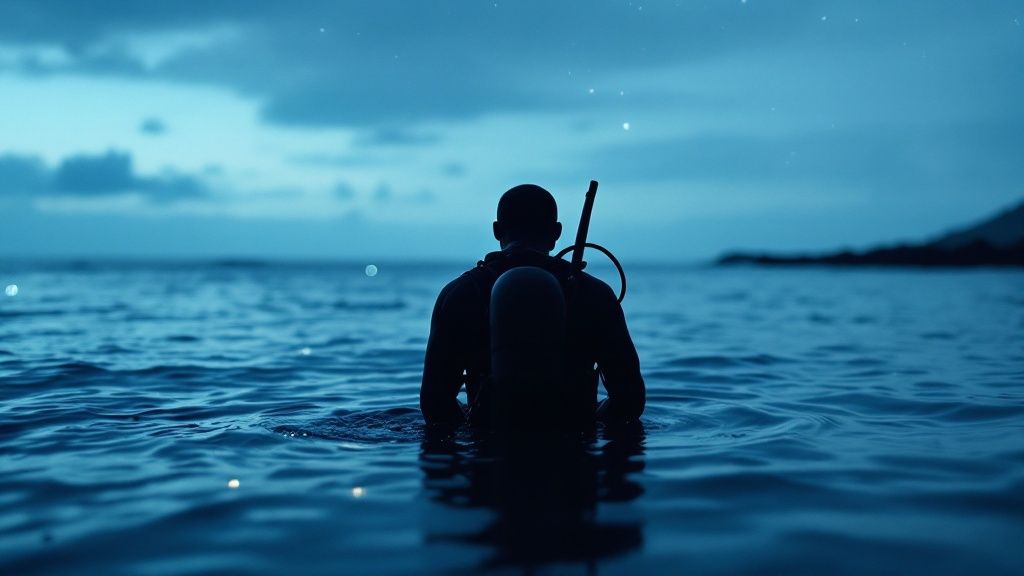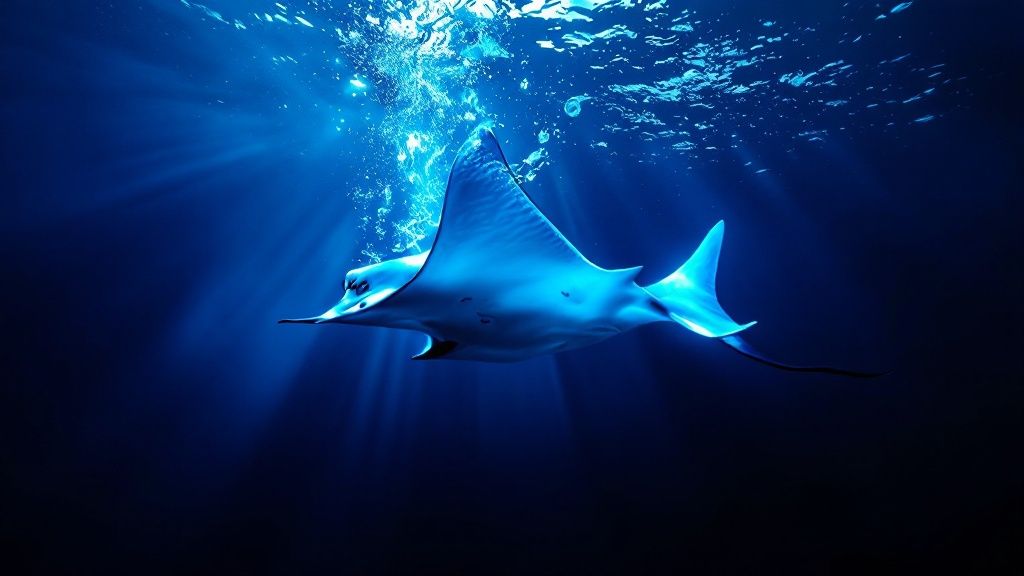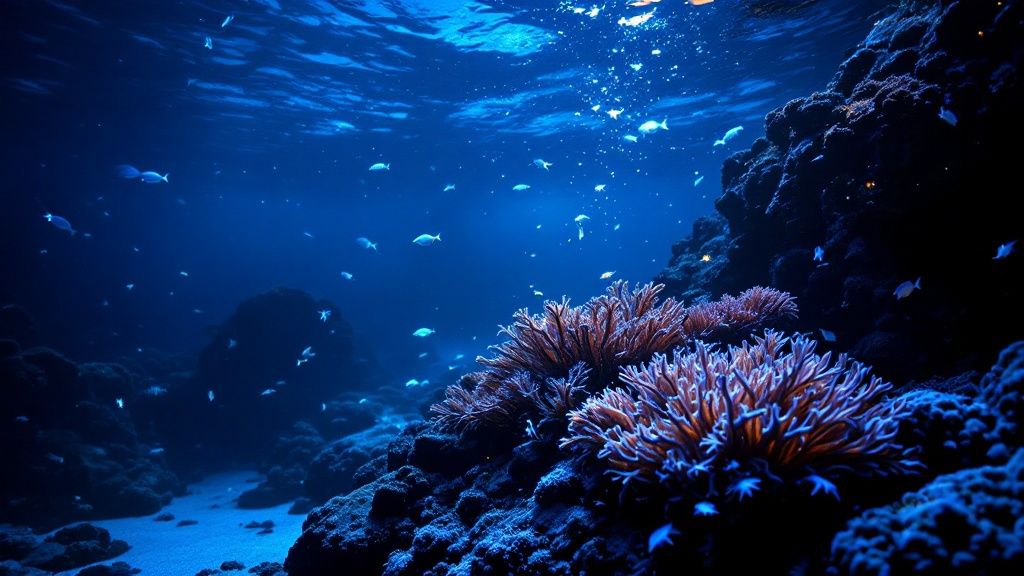The Magic Behind Kona Night Manta Ray Snorkel Experiences

The Kona night manta ray snorkel is an extraordinary wildlife encounter, far beyond a typical tourist activity. Unlike many pre-arranged animal experiences, this adventure hinges on the natural wonders of the Kona coastline, a world-renowned manta ray haven. The magic starts with nutrient-rich upwellings bringing microscopic plankton to the surface. These plankton form the foundation of the food chain, a feast for the manta rays.
These gentle giants, some with 16-foot wingspans, gather each night in a captivating feeding dance, gliding through the moonlit waters. Imagine floating on the surface as these massive creatures, illuminated by underwater lights, execute graceful barrel rolls and backflips just inches below. This is the reality of a Kona night manta ray snorkel.
This unforgettable experience consistently receives top ratings from experienced ocean enthusiasts, often surpassing even whale encounters or cage diving.
The Kona coast of Hawaii boasts an incredibly high success rate, between 80 and 90%, for spotting manta rays on night snorkeling trips. Several factors contribute to this impressive statistic, including the deep, nutrient-rich waters that attract vast amounts of plankton, the manta rays' primary food source.
Additionally, specialized underwater lights enhance the viewing experience by attracting even more plankton, bringing the manta rays closer to snorkelers for remarkable up-close encounters. The activity's popularity attracts thousands of visitors annually, providing invaluable data on the behavior and social dynamics of these magnificent creatures. Learn more: Manta Ray Night Snorkel Experience Guide
Understanding the Manta Ray Feeding Frenzy
The feeding habits of manta rays are central to this magical experience. They use a technique called filter feeding, swimming with their mouths open, filtering plankton-rich water through specialized gill rakers. The underwater lights used during the snorkel intensify this natural phenomenon, creating a concentrated "plankton buffet" that draws the manta rays closer to the surface.
This allows snorkelers an unparalleled view of their unique feeding techniques. The stillness of the night further enhances the experience. As the sun sets, the ocean calms, creating perfect conditions for observing these graceful creatures. The darkness also amplifies the ethereal glow of the underwater lights, truly a magical atmosphere. More Kona snorkel adventures await: Exploring more Kona Snorkel Blog Posts
Preserving the Magic for Future Generations
The success of the Kona night manta ray snorkel underscores the importance of sustainable tourism. Responsible tour operators follow strict guidelines to minimize their impact on the manta rays and their habitat.
These guidelines include maintaining a safe distance, never touching the animals, and using eco-friendly practices. These combined efforts ensure this magical experience remains available for generations to come.
Perfect Timing: When To Book Your Manta Ray Snorkel Adventure

Unlike many marine wildlife encounters, the Kona night manta ray snorkel isn't limited by season. This gives you wonderful flexibility when planning your Hawaiian getaway. Manta ray sightings in Kona are consistently impressive throughout the year. This is because, unlike migratory humpback whales, manta rays stay near their feeding grounds.
They don't migrate with the seasons, meaning there's a good chance of seeing them almost any night. Years of collected data shows that manta rays are spotted over 80% of the time when conditions are right. The actual number of mantas you'll see on any given night can vary quite a bit, adding an element of surprise to every snorkel. Discover more insights about manta ray sightings.
Moon Phases and Visibility
While the time of year isn't critical, the moon phase significantly impacts your Kona night manta ray experience. A darker night sky, ideally during a new or crescent moon, improves the visibility of underwater lights used to attract plankton. These lights create a captivating display, bringing both plankton and the manta rays closer to the surface for optimal viewing.
Weather Conditions
Even the perfect moon phase can't guarantee a perfect viewing. Weather conditions are another key factor. Calm seas are vital for both comfort and clear visibility. Rough waters can make snorkeling difficult and decrease underwater visibility, reducing your chances of seeing the mantas. Checking the marine forecast and selecting a date with calm seas is important for planning your snorkel adventure. You can learn more about our sitemap for additional information.
Practical Timing Considerations
Beyond natural factors, practical timing details can also improve your experience. Sunset times influence tour schedules. Many tours include a sunset option, offering stunning views of the Kona coastline before the manta ray viewing begins. Also, consider the impact of busy tourist seasons. Booking during the shoulder seasons (spring and fall) can create a more personal experience, potentially with smaller tour groups.
Booking Strategies for Optimal Viewing
To maximize your chances of a truly magical, manta-filled night, think about booking your Kona night manta ray snorkel early in your trip. This provides flexibility to reschedule if your first night has less-than-ideal conditions. Many operators offer a "manta guarantee," letting you join another tour for free if you don't see any manta rays on your initial outing. This gives you the best chance of observing these magnificent creatures in their natural habitat.
Legendary Locations: Prime Manta Ray Viewing Sites in Kona

Kona, Hawaii, is a world-renowned destination for manta ray encounters. The Kona coast boasts specific locations that have become legendary amongst manta ray enthusiasts. These sites offer unique underwater topography, resulting in fascinating manta ray behaviors. Two of the most popular sites are Manta Village and Manta Heaven, each providing a distinct experience for those seeking a Kona night manta ray snorkel.
Manta Village: A Shallow-Water Spectacle
Manta Village, nestled in Keauhou Bay, is famous for its shallow, sandy bottom. Averaging around 30 feet deep, this area provides excellent visibility and allows for longer observation times. The shallow depth and calm waters make Manta Village ideal for novice snorkelers, families, and underwater photography. It's the perfect place to witness the mesmerizing feeding rituals of manta rays.
Manta Heaven: A Deep-Water Dance
North of Kona International Airport, you'll find Manta Heaven, a deeper site offering a different perspective. Reaching depths of around 40 feet, Manta Heaven provides a dramatic backdrop for observing these graceful creatures. The deeper water can sometimes attract larger groups of manta rays, creating spectacular feeding formations. However, stronger currents may be present, making this site more suitable for experienced snorkelers.
To help you choose the best site for your experience level, take a look at this comparison table:
Kona Manta Ray Viewing Sites Comparison: A comparison of the main manta ray viewing locations in Kona, highlighting key features and what to expect at each site.
Location Name | Accessibility | Average Manta Sightings | Best For | Water Conditions |
|---|---|---|---|---|
Manta Village | Easy, shallow water | Frequent | Families, beginners, photography | Calm, clear |
Manta Heaven | More challenging, deeper water | Potential for large groups | Experienced snorkelers | Can have stronger currents |
As you can see, each site offers a unique experience. Choose the one that best suits your comfort level and what you hope to see.
The Role of Underwater Terrain in Manta Behavior
The underwater terrain significantly impacts manta ray behavior at these sites. At Manta Village, the flat, sandy bottom allows snorkelers to easily position themselves for optimal viewing. They can watch the mantas perform backflips and barrel rolls as they feed on plankton. At Manta Heaven, the deeper water and varied topography create unique current patterns. These currents influence how the manta rays move and feed, sometimes leading to cooperative feeding, where multiple mantas work together to create a swirling vortex of plankton.
Sustainable Tourism and Habitat Protection
The popularity of Kona night manta ray snorkeling has brought a focus on sustainable tourism. This involves balancing access to these magnificent creatures with the protection of their habitat. Many tour operators now adhere to strict guidelines to minimize disturbance to the manta rays and their environment. These guidelines include maintaining a respectful distance, avoiding touching the animals, and employing eco-friendly practices. Manta Ray Advocates Hawaii has collected valuable data on manta ray sightings and behavior, contributing to our understanding of these creatures. You can explore more related content on our Sitemap. This dedication to sustainability ensures future generations can also experience these incredible encounters.
Preparing For Your Night With Ocean Giants

Getting ready for a Kona night manta ray snorkel is more than just showing up. It's about turning pre-trip nerves into excitement by preparing yourself, both physically and mentally. This involves having the right gear and knowing how to handle common concerns like seasickness or anxieties about swimming at night.
Essential Gear: Staying Comfortable and Safe
A comfortable wetsuit is essential for enjoying your Kona manta ray snorkel. Water temperatures can cool down after sunset, so a well-fitting wetsuit will keep you warm. A well-sealed mask that fits perfectly is also key for clear underwater visibility. This minimizes distractions so you can fully appreciate the manta rays. Consider renting or purchasing a low-volume mask to reduce fogging.
Managing Common Concerns
Seasickness is a common worry for many ocean-goers. Luckily, there are easy solutions. Motion sickness medication or acupressure wristbands can help manage nausea, so you can focus on the manta rays. Many people also worry about swimming at night. Reputable Kona night manta ray snorkel tours prioritize safety, with experienced guides, flotation devices, and well-lit areas.
Check out our guide on how to master your snorkel experience for more helpful tips.
Beyond the Physical: Mental Preparation
Getting ready for your snorkel adventure goes beyond just physical gear. Managing expectations is important. Manta rays are wild animals. While sighting rates are high, around 80-90%, there's no guarantee you'll see many. Even a single encounter with these graceful creatures is an amazing experience. For first-timers, visualizing the experience can help reduce anxiety and increase enjoyment. Imagine floating peacefully, watching the manta rays glide below.
From Pre-Trip Nutrition to Post-Snorkel Celebrations
What you eat can affect how you feel during your adventure. A light, easily digestible meal a few hours before your snorkel is recommended. Avoid heavy, greasy foods that might contribute to seasickness. Staying hydrated is also essential, especially in the Hawaiian climate. After your incredible encounter, celebrate at a local restaurant. Sharing stories and photos with your fellow snorkelers makes the memories even more special. This post-snorkel camaraderie is a perfect way to end a magical night.
Selecting Your Perfect Kona Night Manta Ray Snorkel Tour
Planning a Kona manta ray night snorkel? Not all tours are created equal. While the core activity is the same, the overall experience can vary significantly depending on the tour operator. Smart planning is key to maximizing your manta ray encounter. Don't just compare prices – delve deeper into what each tour offers.
Key Operational Details That Matter
Several factors contribute to an exceptional Kona night manta ray snorkel. Boat design matters. A stable, spacious vessel makes for a comfortable ride, especially if the ocean is a bit choppy. Group size is also crucial. Smaller groups often allow for more personalized interactions with the manta rays and more individual attention from guides.
Guide expertise is essential. Look for certified guides with deep knowledge of manta ray behavior and the local marine environment. Their insights will enhance your understanding of these amazing creatures. And never underestimate the importance of safety protocols. Choose operators who prioritize safety briefings, provide proper flotation devices, and use appropriate lighting for nighttime snorkeling.
Deciphering Comfort Features vs. Marketing Gimmicks
While many tours tout "comfort features," not all are worth the extra cost. Hot beverages and snacks after the snorkel are a nice touch, but focus on the core aspects: boat quality, group size, guide experience, and safety. These are the real indicators of a quality tour. Don't get distracted by marketing gimmicks.
Asking specific questions about conservation practices is essential. Inquire about their efforts to minimize environmental impact and support manta ray research and protection. This helps you identify operators truly dedicated to sustainability. For more on our commitment to conservation, check out our site's pages and sitemap.
Choosing a Tour That Aligns with Your Needs
Kona night manta ray snorkel tours cater to a variety of interests. Family-friendly tours often feature calm waters, shorter snorkel times, and guides experienced with children. Photography-focused excursions provide ample space for equipment and guidance on capturing stunning underwater shots. Some tours even have marine biologists on board for a deeper educational experience.
From basic packages to premium experiences, there's a tour for everyone. Understanding the nuances of each tour will help you select the perfect fit for your group and ensure a magical manta ray encounter.
To help you choose the perfect tour, we've put together a helpful table summarizing different tour options:
Manta Ray Tour Options and Features A breakdown of different tour types, price ranges, and what features to expect from various Kona manta ray snorkel experiences
Tour Type | Average Price | Group Size | Inclusions | Duration | Best For |
|---|---|---|---|---|---|
Basic Snorkel Tour | $100-$150 | 20-30 | Snorkel gear, flotation devices, guide | 2-3 hours | Budget-conscious travelers, first-timers |
Premium Snorkel Tour | $150-$250 | 10-20 | Snorkel gear, wetsuits, hot beverages, snacks, guide | 2-3 hours | Enhanced comfort, smaller groups |
Family Snorkel Tour | $120-$200 | 10-25 | Snorkel gear, flotation devices, child-friendly guide, shorter snorkel time | 2 hours | Families with young children |
Photography Tour | $180-$300 | 10-15 | Snorkel gear, camera assistance, experienced guide | 3-4 hours | Photography enthusiasts |
Marine Biologist Tour | $200-$350 | 10-20 | Snorkel gear, educational presentation, marine biologist guide | 3-4 hours | Nature lovers, educational experience |
This table provides a general overview. Remember to check with individual tour operators for specific details and current pricing.
Behind the Scenes: Identifying Genuine Environmental Stewardship
Look beyond marketing claims and examine the operators' practices. Do they participate in manta ray research initiatives? Do they adhere to strict guidelines regarding boat proximity to the animals? Do they educate participants about responsible snorkeling behavior? These are signs of true environmental stewardship.
Choosing a sustainable operator enhances your experience and contributes to long-term manta ray protection. By making informed decisions, you support responsible tourism and help preserve the magic of Kona night manta ray snorkeling.
The Underwater Ballet: Your Kona Night Manta Ray Encounter Unveiled
Stepping onto the boat for your Kona night manta ray snorkel, you'll feel the anticipation building. After a quick briefing on safety and snorkeling etiquette, a short boat ride takes you to a famed manta ray viewing spot, perhaps Manta Village or Manta Heaven. As the sun sets, painting the Pacific in warm hues, the excitement grows. Then, it's time for the main event: entering the water.
The First Sighting: A Breathtaking Moment
The initial plunge into the dark ocean can be thrilling yet slightly unnerving. But as your eyes adjust, a magical scene emerges. Underwater lights, strategically placed, attract plankton, the manta rays' main food source. Soon, these gentle giants appear from the depths, their enormous wings gliding effortlessly. This first sighting is often described as breathtaking—a moment of pure awe as these magnificent creatures, some with 10-14 foot wingspans, come into view.
Decoding the Manta Ray's Dance: Feeding and Social Behaviors
The Kona night manta ray snorkel offers a unique perspective on a captivating underwater ballet. Drawn by the plankton, the manta rays perform an intricate dance around the lights. They execute mesmerizing barrel rolls and backflips, their movements both powerful and graceful. This filter feeding involves swimming with open mouths, filtering plankton-rich water through specialized gill rakers.
Beyond feeding, you’ll also observe fascinating social interactions. Manta rays are known for their complex communication, using subtle shifts in body posture and fin movements. Observing these interactions offers insights into their social dynamics and intelligence. Different formations, like chain feeding (multiple mantas following in a line) and cooperative feeding (creating a plankton vortex), showcase their teamwork.
Recognizing Individuals: Spot Patterns and Communication
Each manta ray has a unique spot pattern on its underside, like a human fingerprint. Learning to recognize these patterns helps you identify individuals and appreciate their distinct personalities. Experienced guides often name specific mantas, adding a personal touch.
Manta rays communicate mainly through body language. Lacking vocal cords, their subtle movements and postures speak volumes. A backflip might signal feeding readiness, while a slow glide could indicate relaxation. These nuances enrich the snorkel, transforming simple observation into an immersive learning experience.
More Than Just a Vacation Activity: The Emotional Impact
The Kona night manta ray snorkel is more than a checklist item; it's an experience with lasting emotional impact. The close encounter with these gentle giants evokes wonder and connection with nature. Many describe it as transformative, fostering a renewed appreciation for the ocean. It's a powerful reminder of marine life's beauty and fragility, highlighting the importance of conservation.
Ready for the magic? Book your unforgettable adventure with Manta Ray Night Snorkel Kona Hawaii Tours and make memories to last a lifetime.
Yorumlar